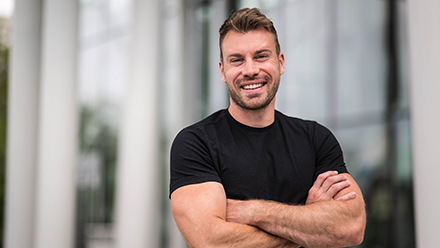How ESAM Gave Mark Cembrowski a Platform for his Successful Brain Research
Cembrowski serves as an associate professor in the Department of Cellular and Physiological Sciences at the University of British Columbia
When Mark Cembrowski (MS ’08, PhD ’11) looks back at his time in the Department of Engineering Sciences and Applied Mathematics at Northwestern Engineering, his mind goes straight to working with different experts in related fields. He combined computational modeling and patch-clamp electrophysiology to study retinal processing with ESAM professors Hermann Riecke and William Kath, but also Joshua Singer, then a professor at the Feinberg School of Medicine.
“Through that combination of those three individuals, I was able to learn a lot of different approaches as it came to mathematics and computation of understanding cells and circuits in the brain,” Cembrowski said. “That is really something that would be almost impossible to find anywhere else.”
That experience still informs Cembrowski’s work.

Now an associate professor in the Department of Cellular and Physiological Sciences at the University of British Columbia (UBC) who recently earned tenure, Cembrowski completed his PhD in applied mathematics in 2011 after attaining a master’s in 2008. Since leaving Northwestern, Cembrowski was employed as a postdoctoral researcher and then research scientist at the Janelia Research Campus at the Howard Hughes Medical Institute before landing at UBC.
At UBC, Cembrowski’s lab works to understand how the brain forms, stores, and retrieves memories, taking a multidisciplinary and multiscale approach. The lab combines cutting-edge experimental techniques with computation, engineering, and mathematics to study memory across the spatial scales of the nervous system: molecules, cells, circuits, and behavior.
As part of his work, Cembrowski interfaces with researchers from varied backgrounds. He honed that crucial skill at Northwestern.
“The lines are getting very blurry between science and math these days, and multidisciplinary scientists and mathematicians are the wave of the future,” Cembrowski said. “Generally, we're getting really good in biology and in science at generating really complex gigantic data sets. And the bottleneck that's emerging is, what is the statistical structure? What are the interesting things that are embedded within that data set? It requires a lot of mathematical expertise and computational knowledge to move from these initial raw and complex data sets into data sets where you can interpret the structure of it and understand the biology.
“In that way, this was a truly invaluable experience at Northwestern.”
To some, the shift from applied math to studying the brain would seem like a jump. Cembrowski views his journey as more of a gradual shift after earning his bachelor’s degree in mathematics at UBC.
“Being in ESAM and having this really wonderful project with Herman and Bill, and with Josh made me begin to appreciate the power of mathematics, and how it can inform our understanding of biology. But also what was really important is that some of the modeling that we did made some really unexpected predictions that were so wild we it couldn’t be true,” Cembrowski said. “The models made a prediction that we took into an experimental space. Then we could use those new experiments to then go back and inform the modeling that we did.
“There's this beautiful synergy that was there of building a mathematically robust and realistic model, using that to inform experiments, and go back and forth. There's really a unique edge to that. And from that I was really able to appreciate if you can find that edge in other projects and continue to push it, you're really in a space where not a lot of other scientists and groups can operate.”
As Cembrowski’s path shows, people holding an ESAM degree can take numerous directions.
“It's so powerful. In terms of the potential of where that degree can bring you, there's a lot of different directions,” he said. “There are no really wrong answers, and it's a degree that doesn't close any doors. It opens a wide variety of doors, and then it gives you the opportunity to pick which door you like the most and walk through it.”
